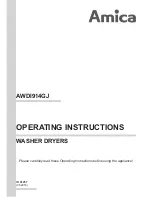
SERVICE TECHNICIAN S USE ONLY
Dishwasher Tech Data Sheet
DO NOT REMOVE: SERVICE TECHNICIAN’S USE
ONLY
WARNING: DISCONNECT APPLIANCE
FROM ELECTRICAL SUPPLY BEFORE
SERVICING.
SPECIFICATIONS
Electrical Supply (Under Load) - 60 Hz - 120 VAC ± 10%
Supply Water Flow Rate - Must fill 1 quart container in
18 seconds.
Supply Water Temperature - 120°F to 150°F (49°C - 66°C)
Before starting dishwasher, run water at sink faucet until
hot.
Thermostat
(some models) - Contacts will close at 122°F
± 5°F (50°C ±3°C). The sump water should heat to
approximately 140° ± 5°F (60°C ±3°C) with outer door in place.
Water Charge - 5 quarts (4.7 liters)
Spray Arm Rotation - 20 to 40 RPM
MOTOR INSTALLATION
Installation of motor to pump housing requires centering of
motor shaft using service tool 154384901
(see illustration
below). Service tool is not packed with motor and must be
ordered separately. Failure to center motor shaft may result in
seal leaks and noisy operation. The centering tool is also used
to install the seal.
Lower pump housing and motor area
• Motor shaft seal damaged or defective.
• Pump housing gasket not seated, screws not tight.
• Pump housing cracked.
• Hose connections loose.
Float area
• Dirty float tube causing float to stick.
Other areas
• Water temperature over 160°F (71°C) causing excessive
condensation.
WASHABILITY COMPLAINTS
Dishes not clean
• Supply water temperature 140°F (60°C) for best results.
• Improper loading.
• Detergent is old, caked or lumpy.
• Detergent cup is not releasing or opening too soon.
• Low water charge due to low water pressure or clogged
water valve.
• Hard water film (water with 12 grains or more hardness
may require a water softener). Use more detergent.
• Etching (usually on glassware) - caused by a
combination of soft water (0 - 4 grains), water
temperature over 160°F (71°C), or too much detergent.
Dishes not dry
• Dishes not loaded to permit proper draining.
• Wetting agent not being used in models equipped with
automatic wetting agent dispenser.
• Supply water temperature under 140°F (60°C). Purge cold
water out of hot water faucet.
• Low voltage supply.
• Cool Dry is being selected when Hot Dry is needed.
• Defective heating element - a good element has a
resistance of 23 to 25 ohms.
Staining
• Coffee or tea - to remove, place items in dishwasher and
add 1 tablespoon of chlorine bleach to the detergent. Run
machine through the cycle. DO NOT LOAD
SILVERWARE OR METAL ITEMS.
• Red or brown stains on the tub or dishes may be caused
by as little as 1 PPM of iron in the water supply. To
remove iron stains from the tub:
1. Remove all dishware and silverware.
2. Pour 8 oz. (224 ml) of resin bed cleaner, used in
water softeners, into bottom of tub.
3. Place detergent in covered cup.
4. Allow dishwasher to run through complete normal
cycle uninterrupted. The dry cycle may be
omitted.
• Hard water film or lime deposit build-up - pour 2 cups of
vinegar into empty dishwasher and run through Rinse/
Hold cycle. Filmed glasses/dishware may also be
cleaned in this manner, but not silverware. Some
commercial products, such as “Lime-A-Way”, may be
available in your area. Caution: Carefully follow
instructions on product container.
(000726)
COMMON CAUSES OF LEAKS
Door Area
• Tub gasket not firmly seated in corners.
• Tub shifted out of square during installation, causing leak
in upper corners.
• Vent baffle not sealing properly against tub dam.
• Spray arm split, open crimp seams, or binding.
• Sudsing, which may be caused by:
• use of non-dishwasher detergent,
• low water temperature (should be 140°F [60°C]),
• inferior dishwasher detergent, not suppressing foam.






















